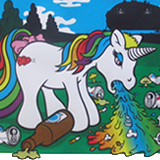|
sincx posted:Or... you know... you can just have the linear motors directly move the train The scale of that photo hurts my brain. Also, L0 is a dumb name for a train.
|
|
|
|

|
| # ? May 10, 2024 12:23 |
|
VictualSquid posted:I think the rod driven electric locomotives replicate the important cool parts well. Yep, that's the future I want to live in. 
|
|
|
|
~Coxy posted:Yep, that's the future I want to live in. Do you need said trains to be full-scale and rideable?...
|
|
|
|
VictualSquid posted:I think the rod driven electric locomotives replicate the important cool parts well.
|
|
|
|
evil_bunnY posted:How could anyone look at this and not think "Hey lads how's about we put the loving motor on the axle next time eh?" Pretty sure a big part of why they did that was the motors were rather inefficient and as such had to be huge to put out the required amount of power. I mean look at the size of those things. What I don't get is why they kept using side rods instead of gearing them directly to the axles.
|
|
|
|
Disgruntled Bovine posted:What I don't get is why they kept using side rods instead of gearing them directly to the axles. Haven't you heard of a little thing called class? 
|
|
|
|
Disgruntled Bovine posted:What I don't get is why they kept using side rods instead of gearing them directly to the axles. When you already have a steam locomotive chassis, every problem starts looking like a tie-rod. Or something.  Itís worth noting that the first steam-turbine ships (including HMS Dreadnought, a 20,000 ton battleship,) had to be direct-drive from the turbine, because large gear reduction sets were developed later. Big gear sets are much harder to make than big power.
|
|
|
|
Actually thinking about this further I have a theory. Since each motor drives multiple axles they couldn't mount them rigidly to the axles like modern locomotives. I'll bet side rods were just an easier way to link a chassis mounted motor to a sprung axle than direct gearing.
|
|
|
|
IIRC there was some plan to design a modern steam locomotive that burns biowaste fuel. It would just use a steam turbine to power traction motors and wouldn't look much different from a diesel. Probably stinkier.
|
|
|
|
FuturePastNow posted:IIRC there was some plan to design a modern steam locomotive that burns biowaste fuel. It would just use a steam turbine to power traction motors and wouldn't look much different from a diesel. Probably stinkier. https://csrail.org/3463 https://csrail.org/
|
|
|
|
rail is already so much more fuel efficient than trucks and lower polluting than steamships that i dont see how this is remotely viable. increasing crew size, which i guess this would require, and increasing maintenance requirements, which this seems like it would, is a non-starter in this environment.
|
|
|
|
|
It's got a lot of goals. They're claiming that diesel has kind of hit its limits for speed, but steam was able to go very fast and we haven't pushed that technology to the edge yet. Additionally they want to use biomass which would be a renewable carbon neutral/negative and therefore much better for the environment than diesel or coal or fuel oil.
|
|
|
|
Wasn't there some report on converting diesel into biogas/natural gas locos and they concluded that they were too explody with how rarely companies do maintenance on engines?
|
|
|
|
I thought the future was electric locos with distributed solar/hydro/whatever power sources anyway.
|
|
|
FISHMANPET posted:It's got a lot of goals. They're claiming that diesel has kind of hit its limits for speed, but steam was able to go very fast and we haven't pushed that technology to the edge yet. Additionally they want to use biomass which would be a renewable carbon neutral/negative and therefore much better for the environment than diesel or coal or fuel oil. the limiting factor for the speed of american freight isn't the fuel source. how the network is organized(quality of planning) and how well its run(adherence to plan, track maintenance, crew avail, power avail) seem to matter a lot more.
|
|
|
|
|
Well their goal is looking in the passenger space, not freight. It looks like things have changed since they first started trying to adapt the Santa Fe locomotive, but the original impetus of the project was this article from Trains written in the 70s: https://static1.squarespace.com/sta..._Locomotive.pdf It sounds like the claim is that there was about to be a revolution in steam technology before the move to steam, and their aim is for higher speed intercity rail. Part of the idea I think is that electrification might be too expensive for a lot of routes in the US, but that a modern steam locomotive could operate at similar speeds to electric trains at similar operating costs. On top of all that, they're also looking at carbon neutral fuels, to reduce the carbon impact of what steam traction would additionally require. It looks like since then they've used their biomass in some narrow gauge steam engines, and they've also gotten grants to build some stationary steam engines using their modern technology.
|
|
|
|
Ding ding ding Old W class trams are finally getting out of storage after being sold to people and schools and towns. https://twitter.com/9NewsMelb/status/1115531853912391681?s=19 A few still exist on the network on tourist routes and as the restraunt trams. https://youtu.be/WE9ZL7pMfrk drunkill fucked around with this message at 15:32 on Apr 9, 2019 |
|
|
|
drunkill posted:Ding ding ding Just to clarify, are at least some getting restored to service or are they mostly just inoperative shells going to private homes, collectors, and preservation groups at this point?
|
|
|
|
FISHMANPET posted:Well their goal is looking in the passenger space, not freight.
|
|
|
|
FISHMANPET posted:Well their goal is looking in the passenger space, not freight. It's an interesting article and I can believe that steam could be more powerful and efficient than diesel with the help of modern technology, but some of what they're saying doesn't make sense. If you look at appendix 1 where they go into details on cost analysis, they claim most of the savings on steam would come from maintenance and repair. This seems ridiculous to me as the technological improvements they tout as the primary reason why steam would have an advantage over diesel are mostly concerned with efficiency and power output. Maybe this is a case of common knowledge being wrong, but my understanding was always that the primary driver behind the conversion to diesel was downtime and maintenance costs. They also mention $400m for "facilities" for diesel, with no cost for steam. Steam locomotives need water towers, coaling towers, turntables, ash pits, etc. How does that equation work? I'd love to see steam back in use as mainline power, and maybe it could be made more efficient than diesel, but the biofuels angle is probably the most important part of their argument, because nobody (outside of the Republican party) is going to get behind putting thousands of coal burning locomotives into service these days.
|
|
|
|
wolrah posted:I think the point was that claims of steam increasing speeds are silly when the main limiting factors on passenger rail speed in the US have nothing to do with what fuel makes the locomotive go. I think that's largely based upon power output. The old adage is a steam locomotive can pull a train at speed which it can't start, and a diesel can start a train that it can't pull at speed. It's easier to get very high horsepower out of steam, and it's easier to get very high tractive effort out of diesel. The PRR T1's were known to maintain speeds of 110-120 mph on some sections of their routes, and that wasn't particularly unusual for the time. With modern technological improvements steam could be a way to create monster horsepower locomotives for high speed passenger travel without the expense of electrification. Of course that doesn't solve the problem of the track infrastructure necessary to support those speeds.
|
|
|
|
drunkill posted:Ding ding ding Why does that green and yellow/beige colour scheme seem so common with trams? The older and newest generation of trams in Helsinki use exactly the same colours and I think some japanese trams have the same colours.
|
|
|
|
Saukkis posted:Why does that green and yellow/beige colour scheme seem so common with trams? The older and newest generation of trams in Helsinki use exactly the same colours and I think some japanese trams have the same colours. That was the colour scheme for the Melbourne Public transport system during the 80s and 90s
|
|
|
|
Neddy Seagoon posted:Just to clarify, are at least some getting restored to service or are they mostly just inoperative shells going to private homes, collectors, and preservation groups at this point? These are the real old unupgraded ones. They restored 30 or so about 15 years ago to remove asbestos and put modern brakes on em etc. Those will remain for use, the ones being sold off dont work anymore and were retired in the 90s but not a scrapped. Some of the upgraded ones made it overseas, theres a few in San Fransisco and New Orleans afaik.
|
|
|
|
Saukkis posted:Why does that green and yellow/beige colour scheme seem so common with trams? The older and newest generation of trams in Helsinki use exactly the same colours and I think some japanese trams have the same colours. I remember seeing some photos of Helsinki trams and was 100% sure I recognised where they were until I looked at the street signs and realised they were definitely not in Melbourne.
|
|
|
|
drunkill posted:These are the real old unupgraded ones. Aside from museum operations, San Francisco, Memphis, and Dallas operate Melbourne trams. I used to operate one and it was easily the best car in the fleet.
|
|
|
|
Disgruntled Bovine posted:It's an interesting article and I can believe that steam could be more powerful and efficient than diesel with the help of modern technology, but some of what they're saying doesn't make sense. I actually looked into this a bit because I thought exactly the same thing you did. I think there's a bunch of handwaving and "this technology (that's untested and unproven) will solve this problem!" going on with the pro-steam side. This presentation goes over some of the tech they expect will save steam: https://www.advanced-steam.org/wp-content/uploads/2017/07/John-Rhodes-Coal-Presentation.pdf. According to that presentation, new tech can reduce lubrication to once every 30 days, boiler blowdowns to once every 60 days, and other improvements. While impressive (assuming it's possible), that still doesn't match diesels being able to go 180+ days without any maintenance at all. Likewise the presentation points out how much cheaper coal and water is compared to diesel, but doesn't even mention how much more manpower is involved with handling coal and water, manning the refilling facilities, etc. That said, there is a case study of a proposed short route at a coal mine in Indonesia where they make a good case that steam may be better than diesel: https://www.advanced-steam.org/wp-content/uploads/2017/07/Chris_Newman_York_Conference_Presentation.pdf. However, that's literally a best case scenario where the fuel is basically made onsite, labor is cheap, and pollution isn't a consideration. Overall the goal seems less about solving problems for railways and more about bringing steam back, which is a cool thought, but not really feasible.
|
|
|
|
Megillah Gorilla posted:I remember seeing some photos of Helsinki trams and was 100% sure I recognised where they were until I looked at the street signs and realised they were definitely not in Melbourne. Hiroshima and Nagasaki have the same colour scheme. Others like Toyama and Kumamoto use the same colours but different scheme. Then some have slightly different shade of yellow. Blackpool had double-decker trams in these colours! There are all sorts of colour schemes for trams, but this is the one that is shared widely. Was it used by the world's oldest tram line or something?
|
|
|
|
If we're going to bring steam back, gently caress it, we might as well use fission to heat the water instead of coal. No? Ok.
|
|
|
|
Saukkis posted:Hiroshima and Nagasaki have the same colour scheme. Others like Toyama and Kumamoto use the same colours but different scheme. Then some have slightly different shade of yellow. Blackpool had double-decker trams in these colours! There are all sorts of colour schemes for trams, but this is the one that is shared widely. Was it used by the world's oldest tram line or something? I honestly have no clue. Maybe cream and green are the cheapest paints to make that aren't pure white? It seems that cream and maroon was the more popular variety in the US, having been used (and still used) by several companies.
|
|
|
|
iospace posted:If we're going to bring steam back, gently caress it, we might as well use fission to heat the water instead of coal. Yes! Fission powered PRR T1 please!
|
|
|
|
Now this I can get behind. Maybe a primary coolant loop of liquid metal too, because gently caress yeah.
|
|
|
|
iospace posted:If we're going to bring steam back, gently caress it, we might as well use fission to heat the water instead of coal. They did design that! There's an article a few pages back about it.
|
|
|
|
There's also the fairly popular fission/electric method, where you keep the operators safe by putting the reactor (and indeed the turbines and generators) in a large stationary building a safe distance from the train.
|
|
|
|
Computer viking posted:There's also the fairly popular fission/electric method, where you keep the operators safe by putting the reactor (and indeed the turbines and generators) in a large stationary building a safe distance from the train. How is that supposed to work when the world freezes and all that still exists is one train?
|
|
|
|
Speaking of steam turbine locomotives, they have existed but most were apparently terrible boondoggles and didn't really work. There were a few that did work (mostly because they dispensed with most of the fancy bells and whistles) and were used in service, and apparently the only preserved steam turbine locomotives in the world are here in Sweden, and they're currently restoring one of the three survivors to running condition (it has been running in museum service before, but was last run in the 1990's, I believe).evil_bunnY posted:How could anyone look at this and not think "Hey lads how's about we put the loving motor on the axle next time eh?" I don't know exactly why they did it like that but it seems to have been relatively common and it lasted for a long time. Check this thing out:  This is a SJ Dm3, which is essentially three D-series locomotives (although with an extra driving wheel axle each) permanently coupled together. Two engines (one per side) and eight driving wheels (four per side) per unit, but the engine isn't directly connected to the axles, instead it's in between the driving wheel axles and connected with tie rods. The design goes back to the 1920's (the SJ D-series electrics) but these heavy variants for iron ore trains are an updated model from the 1960's. The last ones were retired as late as in 2011 (!). e: I may actually have found a reason for the tie rods - apparently it was hard to make a gearbox that was durable enough to handle the torque. TheFluff fucked around with this message at 23:30 on Apr 11, 2019 |
|
|
|
Dm3 are 3 Dm built into one unit and Dm is just an updated Da which used axle mounted engines. Iirc they were actually in use until 2013 but not in regular traffic, just as last resort backup.
|
|
|
|
Computer viking posted:There's also the fairly popular fission/electric method, where you keep the operators safe by putting the reactor (and indeed the turbines and generators) in a large stationary building a safe distance from the train. Well if you're going to do that but want to have a less dense fuel source, you may as well put a diesel motor on wheels that the train can tow to make electricity? Or maybe have it built into it some way?
|
|
|
|
Klaus Kinski posted:Dm3 are 3 Dm built into one unit and Dm is just an updated Da which used axle mounted engines. Iirc they were actually in use until 2013 but not in regular traffic, just as last resort backup. If the engines are axle mounted, what is the thing in the middle then (between the drive wheel pairs)? I was absolutely sure that was the engine. e: wait, okay, it's called a blind axle? I think I'm with you then - one engine per side (per sub-unit), in the middle, axle mounted, but there's no wheel on the axle. That right? TheFluff fucked around with this message at 00:07 on Apr 12, 2019 |
|
|
|

|
| # ? May 10, 2024 12:23 |
|
One engine per axle. The explanation I got is that the rods are some sort of anti slippage? measure. E: one engine per side*2 engines for the dm units may be right. I drove these things a few times and still have gently caress all idea how they work https://www.svenska-lok.se/motor.php?s=20&litra=Dm&typenr= Klaus Kinski fucked around with this message at 00:17 on Apr 12, 2019 |
|
|



































